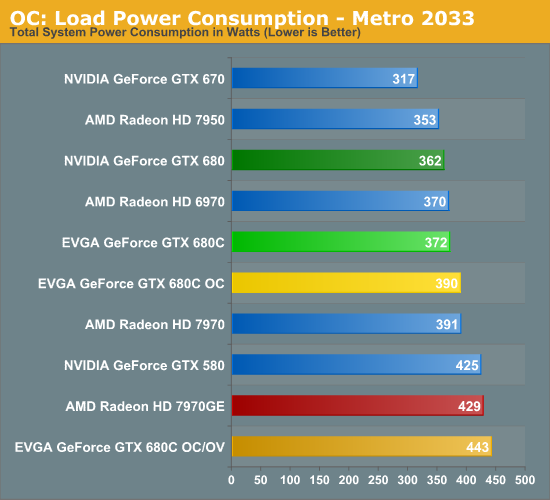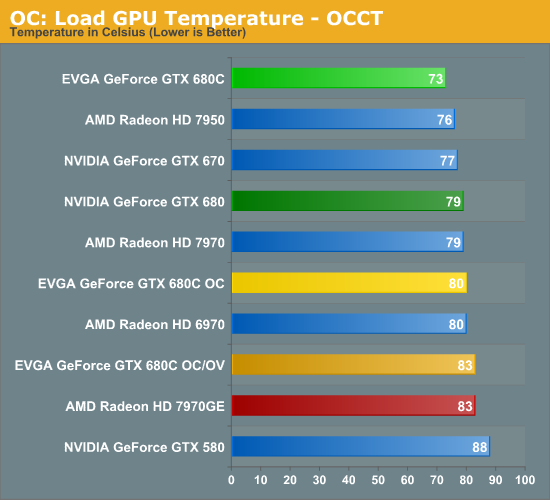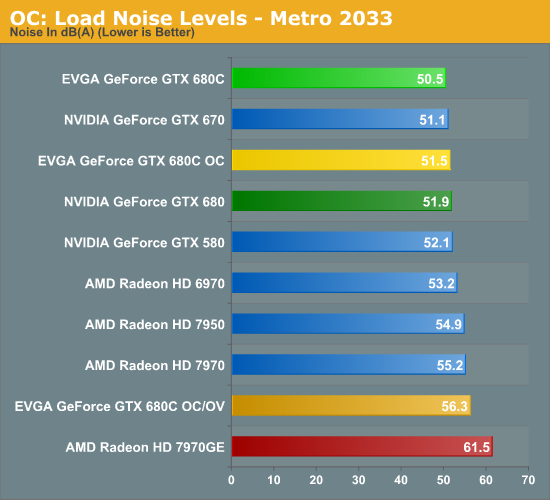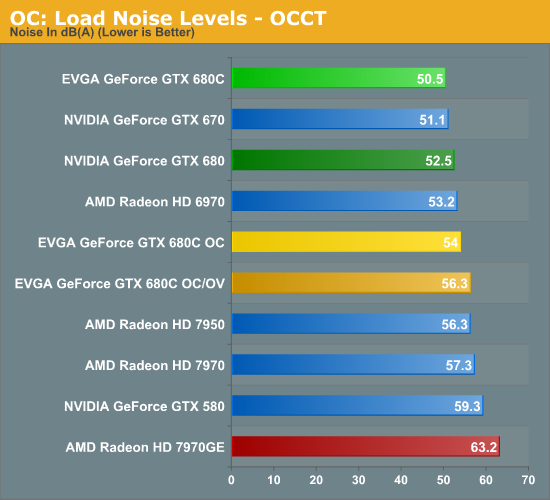EVGA GeForce GTX 680 Classified Review: Pushing GTX 680 To Its Peak
by Ryan Smith on July 20, 2012 12:00 PM ESTOverclocked: Power, Temperature, & Noise
So far our look at the stock performance of the GTX 680 Classified has been more obligatory than critical. The GTX 680 Classified is first and foremost an overclocking card, and while EVGA ships it with a decent factory overclock it’s the end-user overclock that is going to make the GTX 680 Classified stand apart from the crowd.
So how did the GTX 680 Classified fare? As always, we’re going to break our results down into two categories. We’ve overclocked our sample both with and without overvolting it, to get an idea of just how much more headroom is left in the GK104 GPU at stock, and how much more headroom is unlocked through overvolting.
| EVGA GTX 680 Classified Overclocking | |||||
| Stock | OC | OC + OV | |||
| Core Clock | 1111MHz | 1211MHz | 1287MHz | ||
| Max Boost Clock | 1201MHz | 1301MHz | 1377MHz | ||
| Memory Clock | 6GHz | 6.4GHz | 6.5GHz | ||
| Max Boost Voltage | 1.175v | 1.175v | 1.275v | ||
Without overvolting we were able to push our GTX 680 Classified an additional 100MHz(9%) on the core to 1211MHz. Given that we started with what was already a factory overclocked GPU, the fact that this is nearly 100Mhz beyond our next best card should come as no surprise. Binning doesn’t just isolate GPUs that can reach EVGA’s stock specifications, but it isolates those GPUs that can overclock better than the rest too.
Meanwhile on the memory front we were only able to push the memory a further 400MHz to 6.4GHz. This is noticeably less than what we’ve been able to push reference-based GTX 670/680 cards (which have reached nearly 7GHz), and it’s not immediately clear why we’re seeing this difference. With both a custom PCB and additional memory chips it’s possible that either one could be holding back memory overclocking, or more likely it’s a combination of the two. Regardless of the reason this does put the GTX 680 Classified in a bit of a bind, since the GTX 680 is no stranger to memory bandwidth starvation.
As for the impact of overvolting, unfortunately as it turns out overvolting didn’t greatly improve our results. With a core voltage of 1.275v (0.1v over stock) we were able to hit a base clock of 1286MHz, which is just 75MHz higher than what we hit on the stock voltage of 1.175v. In fact both in absolute and relative terms we gained more from our initial stock voltage overclock than we did from the overvolting overclock. Which is not to say that overvolting doesn’t help – clearly it does – but in our limited experience overvolting isn’t unlocking any kind of amazing clockspeed. It’s merely pushing GK104 a bit higher than it can go on stock voltage.
Memory overvolting doesn’t have a particularly great impact either. With a memory voltage of 1.65v we were able to squeeze out another 100MHz with the GTX 680 Classified’s 4GB of GDDR5. Much like the core overclock this is an improvement, but not greatly so.
Ultimately overvolting the GTX 680 Classified most certainly improves its overclockability, but at least on air you won’t be hitting any obscene clocks. Even then we don’t seem to be particularly temperature limited, so it’s not clear whether better (but not extreme) cooling would improve our overclocking results.
But before we jump into our results, there’s one more thing to take into consideration: that pesky power target. EVGA does have a higher power target, but even at 300W+ when using an increased power target, overvolting is going to quickly vault you towards it. The end result is that too much overvolting can make things slower, or at the very least limit the performance gains of what’s already a limited clockspeed increase.
The solution to this is EVGA’s BIOS switch, which effectively removes all of the power limits for the card, but this is not something to be used carelessly. Based on our temperature results with the stock BIOS there’s still some headroom, but the fact that this switch is labeled “LN2” is telling. Disabling all of the power limits is probably not a good idea on the reference cooler, at least in our conservative opinion.
So now that we’ve gone over overclocking in detail, what has it done for power temperature and noise? Let’s find out.


Starting as always with power consumption, as to be expected the impact of overclocking on power consumption varies wildly with whether we’re overvolting. Without overvolting our overclock pushes power consumption at the wall up by 18W in Metro, and a much more significant 49W with OCCT (though do keep in mind that we’ve also raised our power target to +132%). At least as far as games go, without a voltage increase the overall increase in power consumption is fairly small.
Pouring on the voltage significantly increases the power consumption however in both Metro and OCCT. With Metro our power consumption is now 443W at the wall, and with OCCT that’s 425W. This isn’t to say that the overvolting wasn’t worth it, but that additional 75MHz on the core clock and 100MHz memory clock has come with a significant cost.


As to be expected, load temperatures end up reflecting our power consumption figures. Without overvolting we see a 1C increase under Metro and a 7C increase under OCCT. Overvolting pushes the GTX 680 Classified over 80C in all circumstances, topping out at 83C with OCCT. At only 83C there’s still some thermal headroom to play with here for overclocking, but at 1.275v we’re approaching the safe & sane limits for GK104. Users looking to push the voltage harder will want better cooling, but even better cooling may not be enough in the long-run.


Finally we have our look at load noise. Without overvolting we see the overclocked GTX 680 Classified hit 51.5dB, which incredibly enough is still a smidge quieter than the reference GTX 680. For those of you looking for a fairly quiet overclocking card, the GTX 680 Classified is starting to look very good.
As for overvolting, in both Metro and OCCT cause our sample card to hit 56.3dB. This is understandably louder than the reference GTX 680 at this point, though in absolute terms whether it’s particularly loud or not depends on what you’re willing to put up with. The consolation prize here is that even with overclocking and overvolting it’s still 5dB+ quieter than the reference 7970GE.










75 Comments
View All Comments
Grooveriding - Friday, July 20, 2012 - link
Very disappointing card for that price. $660 for this ?The MSI GTX 680 Lightning can also be overclocked and overvolted, showed higher overclocks, has a better cooler and costs less than this card.
More disappointment from EVGA along with their scaled back warranty and the need to pay them additional money for extended warranty coverage/stepup program.
/thumbs down
RussianSensation - Friday, July 20, 2012 - link
$740 for the EVBot controller + a card with a blower fan, dinky heatsink (compared to MSI Lightning 7970/680 and Sapphire TOXIC 7970) is overpriced imo. It's not like the extra 100mhz or 4GB of VRAM over 2GB 1230-1290mhz GTX680s will make this card more future proof for next generation games.To make it even more laughable, this card isn't even close to the fastest factory preoverclocked GTX680 either:
http://www.newegg.com/Product/Product.aspx?Item=N8...
If I wanted the best single-GPU with bragging rights, I'd rather get the GTX690 at that point. The 690 would be much faster and quieter and actually be good to go for next gen games. This seems like a marketing exercise.
Ryan Smith - Friday, July 20, 2012 - link
The thing is that I really don't consider a blower to be a negative thing here. This card barely passed 50dB under load, and at the same time it's fully exhausting. Open air coolers have their place, but not having to worry about additional case cooling is quite convenient.RussianSensation - Saturday, July 21, 2012 - link
Ya, I agree that this blower is one of the better ones. But even from your review, the blower was struggling to keep this card under 70*C with overvolting. Under regular overclocking, it worked perfectly fine but the card only reached 1211MHz (1301 with GPU Boost). Those clocks are nothing special and plenty of $500-560 GTX580s such as Gigabyte Windforce 3x, Asus Direct CUII, Zotac AMP!, Galaxy KFA2 can reach those clocks. So the question is why is this card $660? 4GB of VRAM is a waste at 1080/1200P and at 2560x1600 with AA, 1.2ghz HD7970 is faster.But if you are going to overvolt, the cooler suddenly becomes a limitation, especially after buying EVBot for $740. Suddenly you aren't too far off from a real special card - GTX690 - that's actually going to be fast enough to play today's and next generation games. Going from 1301mhz to 1377mhz with volt mod is not going to make GTX680 any better for newer games since that's not good enough, especially after you consider that because it gets too hot, the delta is less than 76mhz in actual gaming.
Sabresiberian - Sunday, July 22, 2012 - link
The overvolted card reached 83C in the review - but the max recommended temp for a GTX 680 is 98C. It did that keeping the noise down to 56.3dB.I tell you what I think - the people that have problems with EVGA's choice of cooling here is simply that it's not sexy. The fact that it works well is secondary.
The overclocked Classified is faster than the 7970GE in 4/5 games @ 2560x1600 in this review. It's faster in 5/9 of them.
Spunjji - Monday, July 23, 2012 - link
I don't think you can call 56.3dB "keeping the noise down", though. That's approaching conversational levels of noise - more importantly the fans on blower heat-sinks sound subjectively worse; less like the broadband noise of a desk fan and more like the drone of a hair-dryer.So, it's not all about "style". There are other legitimate concerns at play here.
CeriseCogburn - Sunday, July 29, 2012 - link
" Supplying this power is a pair of 8pin PCIe power sockets, which means on paper the GTX 680 Classified can safely draw up to 375W. In practice it’s not clear whether GK104 can actually take that, at least with air cooling, so pushing this card much beyond 300W is mostly in the realm of hardcore water and liquid nitrogen overclockers. "blag blah blah blah: is overpriced imo. It's not like the extra 100mhz or 4GB of VRAM
blah blah blah blah: To make it even more laughable
blah blah blah blah: Those clocks are nothing special
blah blah blah blah: This seems like a marketing exercise
You seem like a moron.
RussianSensation - Sunday, September 2, 2012 - link
We were discussing this card's value vs. the GTX680 Lightning. It's worse than the Lightning in overclocking, price and noise levels. Compared to the 7970, it's ridiculously overpriced and will get beaten by a 1250mhz 7970. So there are at least 2 better options on the market: GTX680 Lightning and Sapphire Vapor-X 7970 GE. Plus, at these prices, you can now get HD7950 Crossfire or catch a sale on 2 GTX670s for $340 each. Sorry but $660 for the Classified is a rip-off.As of September 2, this overpriced pile of garbage is still $660 on Newegg, and then you need to add $60+ for EVBot = $720:
http://www.newegg.com/Product/Product.aspx?Item=N8...
That's a joke and a half. Almost $300 more than the Vapor-X, $180 more than the GTX680 Lightning, and still more expensive than the fastest single GPU this round: Sapphire TOXIC 7970.
Plus, this Classified pile of overpriced marketing will get owned by $640 MSI TwinFrozr III 7950s in CF or $730 GTX670 SLI.
Seriously, only non-nonsensical fanboish noise comes out of your mouth. Even among NV's choices, this card is terrible.
Sabresiberian - Sunday, July 22, 2012 - link
Nice link to a deactivated product in which 4/9 of the people that bought it had trouble. I wonder why it was deactivated? Speaks to the quality of your entire post. "Dinky heatsink". Did you read any of the article at all?Yeah, I'm going to be spending all my video card money on Galaxy products, for sure. I especially like that their card had one DisplayPort and 3 HDMI ports. I'm sure I'm going to run 3 TVs off it.
ubernator44 - Monday, September 17, 2012 - link
alright so you must realize that:1; you will never see the potential out of this card with only air or normal liquid cooling.
2; because of #1 anyone who isnt into phase change/ln2/ or sub zero cooling thinks this is a waste.
you must realize that this thing has 18 power phases O.o like holy crap. the only real perk this card has is its amazing ability to reach extreme clocks at low voltages given the fact you use subzero cooling. anything else is just not adiquate. so yes, for 90% of people, this thing is a 660 dollar brick, for us extreme overclockers, this is a godsend! just look at kingpin and what he got off this beast. for you gamers out there that only use a max of normal liquid cooling, a 680 FTW+ is probly all you will want to pay for. anything else (like this card) is useless to you. so yes, amazing card, small market target, but they made it anyway, which is rare for a company to do!